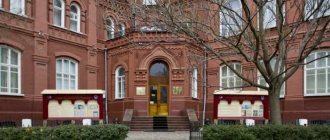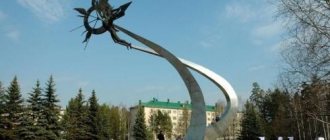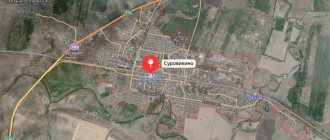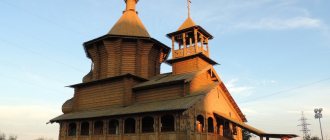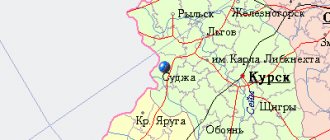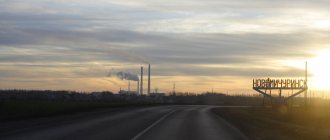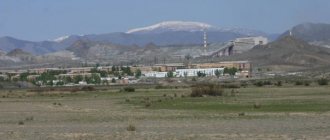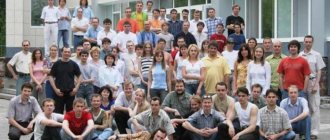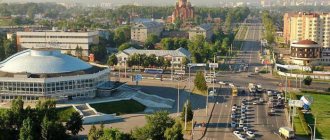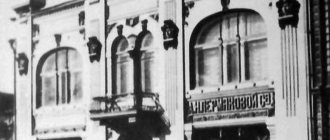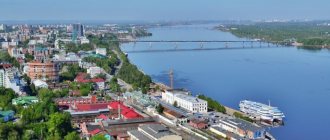| City Urai Flag | Coat of arms |
| A country | Russia, Russia |
| Subject of the federation | Khanty-Mansiysk Autonomous Okrug - YugraKhanty-Mansiysk Autonomous Okrug - Yugra |
| Urban district | Urai city |
| Coordinates | 60°08′00″ n. w. 64°47′00″ E. d. / 60.13333° n. w. 64.78333° E. d. / 60.13333; 64.78333 (G) [www.openstreetmap.org/?mlat=60.13333&mlon=64.78333&zoom=12 (O)] (Z)Coordinates: 60°08′00″ N. w. 64°47′00″ E. d. / 60.13333° n. w. 64.78333° E. d. / 60.13333; 64.78333 (G) [www.openstreetmap.org/?mlat=60.13333&mlon=64.78333&zoom=12 (O)] (I) |
| Chapter | Anatoly Vladimirovich Ivanov |
| Based | in 1922 |
| City with | 1965 |
| Square | 54.3 km² |
| Population | ↗40,477[1] people (2016) |
| Density | 2689.5 people/km² |
| Names of residents | Urayans, Urayets, Urayka |
| Timezone | UTC+5 |
| Telephone code | +7 34676 |
| Postcode | 628285 |
| Vehicle code | 86 |
| OKATO code | [classif.spb.ru/classificators/view/okt.php?st=A&kr=1&kod=71138 71 138] |
| Urai Moscow |
| : Incorrect or missing image Khanty-Mansiysk Urai |
K: Settlements founded in 1922
Urai
- a city in Russia, in the Khanty-Mansiysk Autonomous Okrug - Ugra.
Population - 40,477[1] people. (2016).
The head of the city of Urai is Anatoly Vladimirovich Ivanov.
Geography
The territory area is 54.3 km². Coordinates: 60°08″00″ N. w. 64°47″00″ E. d.
The city of Urai is located in the Ekaterinburg time zone. The offset relative to UTC is +5:00. Relative to Moscow time, the time zone has a constant offset of +2 hours and is designated in Russia accordingly as MSK+2.
The city of Urai is located on the Tavdinsko-Kondinskaya sloping plain. The morphostructure is negative (lowland), involved in uplift (up to 100 m in absolute levels). Type of morphostructures: predominantly straight heterogeneous.
The main part of the city is located on the first flat above-floodplain terrace, in places with well-defined forms of river erosion and accumulation with a relative height of 8-14 m. With distance from the Konda River, the fourth above-floodplain terrace begins (lacustrine-alluvial plain), flat-undulating, significantly reworked by denudation.
Climate
The city of Urai and the Urai urban district are equated to regions of the Far North.
Urai has a temperate continental climate with short warm summers and long cold winters. Urai is the most favorable place in the Khanty-Mansiysk Okrug in terms of climate. The duration of sunshine is 1800–1900 hours (for comparison, Surgut 1600–1700), the annual temperature range is about 36 C° (Surgut more than 38 C°), the duration of the period with an average daily temperature of more than 0 C° is 185 days (Surgut less than 170, Khanty- Mansiysk is just over 170 days), precipitation is 400-450 mm per year, with an average of 165 days of precipitation per year in Uray. Spring begins in the city (destruction of stable snow cover in the field) a little later on April 15 (in Ishim 11.4, in Surgut 28.4). At the end of May, the average daily temperature crosses the border of +10 C°. The average duration of the frost-free period is more than 105 days a year. For about 60 days in the city, the average daily temperature exceeds +15 C°. The duration of stable frosts is about 143 days (Khanty-Mansiysk more than 150 days), the number of days with blizzards is just over 30 days (Surgut more than 50 days a year).
Permafrost
Several tens of kilometers south of the city lies the southern border of the distribution of permafrost (disconnected), the deep occurrence of ancient permafrost (watershed-valley type). Thus, permafrost is no longer found at the entrances to the village of Mezhdurechensky.
| Climate of Urai | |||||||||||||
| Index | Jan. | Feb. | March | Apr. | May | June | July | Aug. | Sep. | Oct. | Nov. | Dec. | Year |
| Average maximum, °C | −14 | −12 | −2 | 6 | 13 | 21 | 23 | 19 | 13 | 4 | −6 | −12 | 5 |
| Average minimum, °C | −23 | −22 | −13 | −4 | 3 | 9 | 12 | 9 | 4 | −3 | −13 | −20 | −5 |
| Source: [www.sunmap.eu/ru/weather/europe/russia/khanty-mansiyskiy-avtonomnyy-okrug/uray Sunmap] | |||||||||||||
Routes on the map of Uray. Transport infrastructure
The transport infrastructure of the city of Urai on a satellite map includes an airport, a river station and a highway connecting the settlement with Khanty-Mansiysk and the cities of the Tyumen region. Its length is 431 km. Highways connect Urai with Mortka, Sovetsky, Ushya, Mylmya village and the village. Mezhdurechensky (train station Ustye-Akha).
Air communication is established with Tyumen, Khanty-Mansiysk, Yekaterinburg and Moscow. The airport's daily schedule includes four flights.
Public transport is represented by buses and minibuses. The city is located 162 km from the nearest railway station Ustye-Akha. Bus services are carried out in the directions of Ustye-Akha, Khanty-Mansiysk, Nyagan, Surgut, Nefteyugansk and Sovetsky.
Story
In 1922, at the mouth of the confluence of the Kolosya River and the Konda River, settlers from Central Russia founded the village of Urai. At the end of the twenties of the 20th century, a fishing artel named after the Decembrists was organized in the village of Urai of the Shaim Village Council. In 1957, a master plan was drawn up for the construction of the village of Urai on an area of 57.0 hectares. On May 25, 1959, not far from the village of Chantyrya, the first exploration well of the Shaim deep drilling party of the Khanty-Mansiysk integrated geological exploration expedition was laid; June 16, 1959 detailed study of the river. Conde and its tributaries. When testing the Malo-Atlymskaya well, the first oil in the region was obtained, containing up to 62% light oil products. At the end of September 1959, well No. 2 in the Mulymyinskaya area produced high-quality oil with a flow rate of up to 1 m3/day. In 1960, the first oil field in Western Siberia (Shaimskoye) was discovered here and its development began. On July 31, 1962, by decision of the Executive Committee of the Kondinsky District Council of Workers' Deputies, Khanty-Mansiysk National District of the Tyumen Region No. 212/1, the workers' village of Urai was organized, a year later the first village Council was elected. On June 25, 1965, by the Decree of the Presidium of the Supreme Soviet of the RSFSR, the village was given the status of a city of district subordination. Since 2006 it has the status of a city district.
Main streets of Urai
The most significant streets of the city of Urai on the map are the following:
- st. Lenina - starts from the park of the Urayneftegaz Chamber of Commerce and Industry and ends at the intersection with Beregovaya Street; on the street Lenin is located the Children's Creativity Center, Uray Polytechnic College, the central office of the Urayneftegaz Chamber of Commerce and Industry, a maternity hospital and a children's clinic;
- st. Cosmonauts - separates 1A microdistrict and 2A microdistrict, on it the Drilling Expedition Military Commissariat and other buildings are located;
- st. Uzbekistan - starts from the intersection with the street. Cosmonauts and continues southeast to Parkovaya Street, here is the Church of the Nativity of the Virgin Mary, the Urai Correctional School and other buildings;
- st. Yuzhnaya is the longest street, located in the southern part of the city; The street starts from a roundabout in the southwest of Urai and ends at the intersection with Uzbekistan Street.
Economy
Urai is a single-industry town. The main oil and gas production enterprise "Urayneftegaz" is part of the oil industry. The Shaim-Tyumen oil pipeline begins in the city.
In addition to enterprises servicing oil production, the city has a number of food industry and service enterprises.
The following commercial banks operate in Urai: Uray branch No. 7961 of Sberbank of the Russian Federation, additional office of the Tyumen branch of CB Stroykredit, additional office of the Kogalym branch of Petrocommerce Bank, additional office of OJSC Khanty-Mansiysk Bank, non-bank credit organization EKPA, operational office of OJSC "SKB-Bank" in Yekaterinburg, a branch of the Yekaterinburg bank "Ring of the Urals".
In February 2009, Uraikombank LLC ceased its activities.
Culture and education
A branch of the Tyumen Oil and Gas University operated in the city.
The branch of Tyumen State University in Urai began its work in 1995. The head and founder of the branch is Vladimir Nikolaevich Gribov, candidate of pedagogical sciences. In 2009, the branch was closed.
There is a museum of the history of the city.
At the Neftyanik Palace of Culture there is the People's Theater-Studio “Avos...” (founded in 1974, since 1990 under the direction of Nelly Shkurenko); The repertoire includes performances for children based on the works of E. Schwartz, K. Sergienko, folk tales, comedies by B. Ratzer and V. Konstantinov, Samuil Aleshin, Leonid Filatov, Aldo Nikolai, complex dramaturgy by Eugene Ionesco and Lyudmila Petrushevskaya. In the city there are also the People's Theater "Blue Bird", a winner of All-Russian and regional theater competitions, and the OSHUT "Terra Incognita" (the theater group of the gymnasium).
The national circus group "Yunost" is the great pride of the city. Founded in 1982. The title “national” was awarded in 1986. Since its formation, the group has taken part in and organized more than 2 thousand (2820) concerts.
Sights of the city of Urai
Squares and parks
The best places for relaxation and family walks in the city of Urai are the central city square , a cultural and recreation park with entertainment attractions , and the Neftyanik square . For the youngest residents of the city, there is a park called “Solnyshko” with the first sundial in Ugra and an adaptive children’s playground. The exact location of objects can be found on the map of Urai with houses.
Monuments
The following monuments are located within the city:
- Monument to the Discoverers of West Siberian Oil , located on Discoverers Square;
- Memorial of Memory , completing the Walk of Fame;
- Sculptural composition “Connection of Generations” , located on the Alley of Labor Glory in the central city square;
- Monument to Saints Peter and Fevronia.
Cultural institutions
Residents of Uray can spend their cultural leisure time at the Museum of History , the Cinema and Concert Circus Complex “Youth of Shaim” and the cultural one . The first cultural institution presents an exhibition of household items of the indigenous Khanty-Mansi inhabitants and the first Russian settlers of Ugra.
The Youth of Shaim complex houses a modern concert hall. And in the Neftyanik cultural and leisure center, city residents are invited to develop theatrical art.
Notes
- ↑ 123
www.gks.ru/free_doc/doc_2016/bul_dr/mun_obr2016.rar Population of the Russian Federation by municipalities as of January 1, 2016 - ↑ 12345678
www.MojGorod.ru/hmao/uraj/index.html People's encyclopedia “My City”. Urai - [demoscope.ru/weekly/ssp/rus70_reg2.php All-Union Population Census of 1970 The size of the urban population of the RSFSR, its territorial units, urban settlements and urban areas by gender.] (Russian). Demoscope Weekly. Retrieved September 25, 2013. [www.webcitation.org/6GDOiMstp Archived from the original on April 28, 2013].
- [demoscope.ru/weekly/ssp/rus79_reg2.php All-Union Population Census of 1979 The size of the urban population of the RSFSR, its territorial units, urban settlements and urban areas by gender.] (Russian). Demoscope Weekly. Retrieved September 25, 2013. [www.webcitation.org/6GDOjhZ5L Archived from the original on April 28, 2013].
- [demoscope.ru/weekly/ssp/rus89_reg2.php All-Union Population Census of 1989. Urban population]. [www.webcitation.org/617x0o0Pa Archived from the original on August 22, 2011].
- [www.perepis2002.ru/ct/doc/1_TOM_01_04.xls All-Russian Population Census 2002. Volume. 1, table 4. Population of Russia, federal districts, constituent entities of the Russian Federation, districts, urban settlements, rural settlements - regional centers and rural settlements with a population of 3 thousand or more]. [www.webcitation.org/65AdCU0q3 Archived from the original on February 3, 2012].
- [www.gks.ru/bgd/regl/b08_14t/IssWWW.exe/Stg/ur/05-00.htm Cities of the Khanty-Mansiysk Autonomous Okrug - Ugra (number of inhabitants - estimate as of January 1, 2008, thousand people) ]. Retrieved July 11, 2016. [www.webcitation.org/6ivWjf9ee Archived from the original on July 11, 2016].
- [www.gks.ru/bgd/regl/B09_109/IssWWW.exe/Stg/d01/tabl-21-09.xls Number of permanent population of the Russian Federation by cities, urban-type settlements and districts as of January 1, 2009]. Retrieved January 2, 2014. [www.webcitation.org/6MJmu0z1u Archived from the original on January 2, 2014].
- [tumstat.gks.ru/wps/wcm/connect/rosstat_ts/tumstat/resources/22904e804154168ab3dff7367ccd0f13/part+1.rar All-Russian population census 2010. Population size and its distribution in the Tyumen region]. Retrieved May 10, 2014. [www.webcitation.org/6PTJWMhJj Archived from the original on May 10, 2014].
- www.gks.ru/dbscripts/munst/munst71/DBInet.cgi?pl=8112027 Tyumen region. Estimated resident population as of January 1, 2009-2016
- [www.gks.ru/free_doc/doc_2012/bul_dr/mun_obr2012.rar Population of the Russian Federation by municipalities. Table 35. Estimated resident population as of January 1, 2012]. Retrieved May 31, 2014. [www.webcitation.org/6PyOWbdMc Archived from the original on May 31, 2014].
- [www.gks.ru/free_doc/doc_2013/bul_dr/mun_obr2013.rar Population of the Russian Federation by municipalities as of January 1, 2013. - M.: Federal State Statistics Service Rosstat, 2013. - 528 p. (Table 33. Population of urban districts, municipal districts, urban and rural settlements, urban settlements, rural settlements)]. Retrieved November 16, 2013. [www.webcitation.org/6LAdCWSxH Archived from the original on November 16, 2013].
- [www.gks.ru/free_doc/doc_2014/bul_dr/mun_obr2014.rar Table 33. Population of the Russian Federation by municipalities as of January 1, 2014]. Retrieved August 2, 2014. [www.webcitation.org/6RWqP50QK Archived from the original on August 2, 2014].
- [www.gks.ru/free_doc/doc_2015/bul_dr/mun_obr2015.rar Population of the Russian Federation by municipalities as of January 1, 2015]. Retrieved August 6, 2015. [www.webcitation.org/6aaNzOlFO Archived from the original on August 6, 2015].
- taking into account the cities of Crimea
- [www.gks.ru/free_doc/doc_2016/bul_dr/mun_obr2016.rar Population of the Russian Federation by municipalities as of January 1, 2016. Table “31. Population of cities and towns by federal districts and constituent entities of the Russian Federation as of January 1, 2016.” RAR archive (1.0 MB)]
- [parovoz.com/newgallery/pg_view.php?ID=33900 View photo]. [archive.is/HAYRw Archived from the original on January 31, 2013].
Excerpt characterizing Urai
Pierre knew very well what a hieroglyph was, but did not dare to speak. He listened silently to the rhetorician, feeling from everything that the tests would begin immediately. “If you are firm, then I must begin to introduce you,” said the rhetorician, approaching Pierre closer. “As a sign of generosity, I ask you to give me all your precious things.” “But I have nothing with me,” said Pierre, who believed that they were demanding that he give up everything he had. - What you have on: watches, money, rings... Pierre hastily took out his wallet, watch, and for a long time could not remove the wedding ring from his fat finger. When this was done, the Mason said: “As a sign of obedience, I ask you to undress.” - Pierre took off his tailcoat, vest and left boot as directed by the rhetorician. The Mason opened the shirt on his left chest, and, bending down, lifted his trouser leg on his left leg above the knee. Pierre hastily wanted to take off his right boot and roll up his trousers in order to save a stranger from this labor, but the Mason told him that this was not necessary - and handed him a shoe on his left foot. With a childish smile of modesty, doubt and self-mockery, which appeared on his face against his will, Pierre stood with his arms down and legs apart in front of his brother the rhetorician, awaiting his new orders. “And finally, as a sign of sincerity, I ask you to reveal to me your main passion,” he said. - My passion! I had so many,” Pierre said. “That passion which, more than any other, made you hesitate on the path of virtue,” said the Mason. Pierre paused, searching. "Wine? Consolidation? Idleness? Laziness? Hotness? Anger? Women?" He went over his vices, mentally weighing them and not knowing which one to give priority to. “Women,” Pierre said in a quiet, barely audible voice. The Mason did not move or speak for a long time after this answer. Finally he moved towards Pierre, took the handkerchief lying on the table and again blindfolded him. – For the last time I tell you: turn all your attention to yourself, put chains on your feelings and look for bliss not in passions, but in your heart. The source of bliss is not outside, but within us... Pierre already felt within himself this refreshing source of bliss, now filling his soul with joy and tenderness. Soon after this, it was no longer the former rhetorician who came for Pierre into the dark temple, but the guarantor Villarsky, whom he recognized by his voice. To new questions about the firmness of his intentions, Pierre answered: “Yes, yes, I agree,” and with a radiant childish smile, with an open, fat chest, unevenly and timidly walking with one barefoot and one shod foot, he went forward with Villarsky placed at his side. bare chest with a sword. From the room he was led along corridors, turning back and forth, and finally led to the doors of the box. Villarsky coughed, he was answered with Masonic knocks of hammers, the door opened in front of them. Someone's bass voice (Pierre's eyes were still blindfolded) asked him questions about who he was, where, when he was born? etc. Then they took him somewhere again, without untying his eyes, and while he walked they told him allegories about the labors of his journey, about sacred friendship, about the eternal Builder of the world, about the courage with which he must endure labor and danger . During this journey, Pierre noticed that he was called either a seeker, or a sufferer, or a demander, and at the same time they knocked him with hammers and swords in different ways. While he was being led to some subject, he noticed that there was confusion and confusion between his leaders. He heard how the surrounding people argued among themselves in whispers and how one insisted that he be led along some kind of carpet. After this, they took his right hand, placed it on something, and with his left they ordered him to put a compass to his left chest, and forced him, repeating the words that the other was reading, to read the oath of allegiance to the laws of the order. Then they put out the candles, lit alcohol, as Pierre heard by the smell, and said that he would see a small light. The bandage was removed from him, and Pierre, as if in a dream, saw, in the faint light of the alcohol fire, several people who, wearing the same aprons as the rhetorician, stood opposite him and held swords pointed at his chest. Between them stood a man in a white, bloody shirt. Seeing this, Pierre moved his chest forward towards the swords, wanting them to stick into him. But the swords pulled away from him and the bandage was immediately put on him again. “Now you have seen a small light,” someone’s voice told him. Then they lit the candles again, said that he needed to see the full light, and again they took off the blindfold and more than ten voices suddenly said: sic transit gloria mundi. [This is how worldly glory passes.] Pierre gradually began to come to his senses and look around the room where he was and the people in it. Around a long table covered in black sat about twelve people, all in the same clothes as those he had seen before. Pierre knew some of them from St. Petersburg society. An unfamiliar young man sat in the chair, wearing a special cross around his neck. On the right hand sat the Italian abbot, whom Pierre had seen two years ago at Anna Pavlovna's. There was also one very important dignitary and a Swiss tutor who had previously lived with the Kuragins. Everyone was solemnly silent, listening to the words of the chairman, who was holding a hammer in his hand. There was a burning star embedded in the wall; on one side of the table there was a small carpet with various images, on the other there was something like an altar with a Gospel and a skull. Around the table there were 7 large, church-like candlesticks. Two of the brothers brought Pierre to the altar, put his legs in a rectangular position and ordered him to lie down, saying that he was throwing himself towards the gates of the temple. “He must get a shovel first,” one of the brothers said in a whisper. - A! completeness please,” said another. Pierre, with confused, myopic eyes, disobeying, looked around him, and suddenly doubt came over him. "Where I am? What am I doing? Are they laughing at me? Will I be ashamed to remember this? But this doubt lasted only for an instant. Pierre looked back at the serious faces of the people around him, remembered everything he had already gone through, and realized that he could not stop halfway. He was horrified by his doubt and, trying to evoke in himself the former feeling of tenderness, he threw himself towards the gates of the temple. And indeed a feeling of tenderness, even stronger than before, came over him. When he had been lying there for some time, they told him to get up and put on him the same white leather apron that the others were wearing, they gave him a shovel and three pairs of gloves, and then the great master turned to him. He told him to try not to stain the whiteness of this apron, which represents strength and purity; then about the unknown shovel he said that he should work with it to cleanse his heart from vices and condescendingly smooth over the heart of his neighbor with it. Then about the first men’s gloves he said that he could not know their meaning, but must keep them, about other men’s gloves he said that he should wear them in meetings, and finally about the third women’s gloves he said: “Dear brother, and these women’s gloves are for you.” the essence is determined. Give them to the woman you will honor the most. With this gift, assure the one whom you choose as a worthy stonemason of the integrity of your heart.” And after being silent for a while, he added: “But be careful, dear brother, that these gloves are not adorned by unclean hands.” While the great master uttered these last words, it seemed to Pierre that the chairman was embarrassed. Pierre became even more embarrassed, blushed to the point of tears, like children blush, began to look around restlessly, and an awkward silence ensued. This silence was interrupted by one of the brothers, who, leading Pierre to the carpet, began to read from a notebook an explanation of all the figures depicted on it: the sun, the moon, the hammer. a plumb line, a shovel, a wild and cubic stone, a pillar, three windows, etc. Then Pierre was assigned his place, they showed him the signs of the box, said the opening word and finally allowed him to sit down. The Great Master began to read the charter. The charter was very long, and Pierre, from joy, excitement and shame, was not able to understand what was being read. He listened only to the last words of the charter, which he remembered. “In our temples we do not know other degrees,” the great master read, “except those that are between virtue and vice. Beware of making any distinction that might violate equality. Fly to the aid of your brother, no matter who he is, guide the erring one, lift up the falling one, and never harbor anger or enmity against your brother. Be kind and friendly. Stir up the fire of virtue in all hearts. Share your happiness with your neighbor, and may envy never disturb this pure pleasure. Forgive your enemy, do not take revenge on him, except by doing him good. Having thus fulfilled the highest law, you will find traces of the ancient majesty you have lost.”
